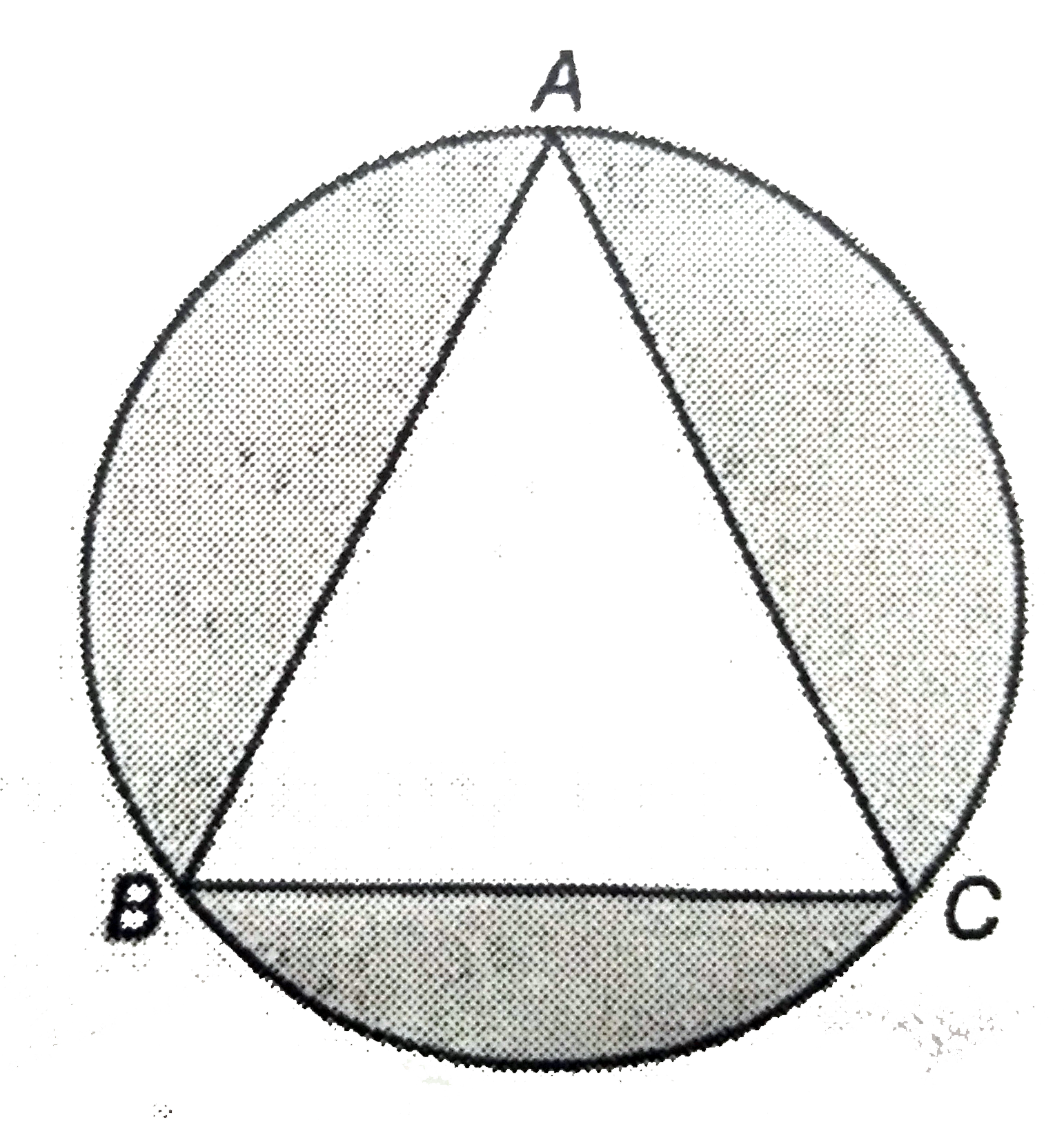If an isosceles triangle ABC , in which AB = AC = 10 cm , is inscribed in a circle of radius 10 cm , find the area of the triangle .
The correct Answer is:25√3cm2
To find the area of the isosceles triangle ABC inscribed in a circle of radius 10 cm, where AB = AC = 10 cm, we can follow these steps:
Step 1: Understand the Geometry
We have an isosceles triangle ABC with AB = AC = 10 cm. The circle in which the triangle is inscribed has a radius of 10 cm. The center of the circle is O.
Step 2: Identify Key Points
Let D be the midpoint of BC. Since triangle ABC is isosceles, AD (the height from A to BC) will also bisect BC. Thus, BD = DC = x.
Step 3: Use the Pythagorean Theorem
In triangle ADB, we can apply the Pythagorean theorem:
AB2=AD2+BD2
Substituting the known values:
102=AD2+x2
This simplifies to:
100=AD2+x2 (Equation 1)
Step 4: Use the Circle's Radius
In triangle ODB, where O is the center of the circle, we also apply the Pythagorean theorem:
OB2=OD2+BD2
Since OB is the radius of the circle:
102=OD2+x2
This simplifies to:
100=OD2+x2 (Equation 2)
Step 5: Express OD in Terms of AD
Since D is the midpoint of BC, we can express OD in terms of AD:
OD=10−AD
Substituting this into Equation 2 gives:
100=(10−AD)2+x2
Expanding this:
100=100−20AD+AD2+x2
This simplifies to:
20AD=AD2+x2 (Equation 3)
Step 6: Solve the Equations
Now we have two equations:
1. 100=AD2+x2 (Equation 1)
2. 20AD=AD2+x2 (Equation 3)
From Equation 1, we can express x2 as:
x2=100−AD2
Substituting this into Equation 3:
20AD=AD2+(100−AD2)
This simplifies to:
20AD=100
Thus:
AD=5
Step 7: Find x
Substituting AD=5 back into Equation 1 to find x:
100=52+x2
100=25+x2
x2=75
Thus:
x=5√3
Step 8: Calculate the Area of Triangle ADB
The area of triangle ADB can be calculated using the formula:
Area=12×base×height
Here, base BD=x=5√3 and height AD=5:
AreaADB=12×5√3×5=25√32
Step 9: Find the Area of Triangle ABC
Since triangle ABC is composed of two triangles ADB and ADC:
AreaABC=2×AreaADB=2×25√32=25√3
Final Answer
The area of triangle ABC is:
AreaABC=25√3cm2
We have an isosceles triangle ABC with AB = AC = 10 cm. The circle in which the triangle is inscribed has a radius of 10 cm. The center of the circle is O.
Let D be the midpoint of BC. Since triangle ABC is isosceles, AD (the height from A to BC) will also bisect BC. Thus, BD = DC = x.
In triangle ADB, we can apply the Pythagorean theorem:
AB2=AD2+BD2
Substituting the known values:
102=AD2+x2
This simplifies to:
100=AD2+x2 (Equation 1)
In triangle ODB, where O is the center of the circle, we also apply the Pythagorean theorem:
OB2=OD2+BD2
Since OB is the radius of the circle:
102=OD2+x2
This simplifies to:
100=OD2+x2 (Equation 2)
Since D is the midpoint of BC, we can express OD in terms of AD:
OD=10−AD
Substituting this into Equation 2 gives:
100=(10−AD)2+x2
Expanding this:
100=100−20AD+AD2+x2
This simplifies to:
20AD=AD2+x2 (Equation 3)
Now we have two equations:
1. 100=AD2+x2 (Equation 1)
2. 20AD=AD2+x2 (Equation 3)
x2=100−AD2
Substituting this into Equation 3:
20AD=AD2+(100−AD2)
This simplifies to:
20AD=100
Thus:
AD=5
Substituting AD=5 back into Equation 1 to find x:
100=52+x2
100=25+x2
x2=75
Thus:
x=5√3
The area of triangle ADB can be calculated using the formula:
Area=12×base×height
Here, base BD=x=5√3 and height AD=5:
AreaADB=12×5√3×5=25√32
Since triangle ABC is composed of two triangles ADB and ADC:
AreaABC=2×AreaADB=2×25√32=25√3
The area of triangle ABC is:
AreaABC=25√3cm2
Topper's Solved these Questions
- CIRCLES BOOK - VK GLOBAL PUBLICATIONCHAPTER - CIRCLES EXERCISE - SELF - ASSESSMENT TEST
11 Videos
- CIRCLES BOOK - VK GLOBAL PUBLICATIONCHAPTER - CIRCLES EXERCISE - PROFICIENCY EXERCISE (Short Answer Questions - II 3 mark)
22 Videos
- ARITHMETIC PROGRESSIONS BOOK - VK GLOBAL PUBLICATIONCHAPTER - ARITHMETIC PROGRESSIONS EXERCISE - SELF ASSESSMENT TEST
10 Videos
- COORDINATE GEOMETRY BOOK - VK GLOBAL PUBLICATIONCHAPTER - COORDINATE GEOMETRY EXERCISE - SELF-ASSESSMENT TEST
10 Videos
Similar Questions
Knowledge Check
In the figure , triangle ABC is isosceles in which AB = AC = 6 cm . If the radius of circle is 9 cm then what is the area of the triangle?
A8√2cm2B8cm2C2√2cm2D8√2cm2A right angled isosceles triangle is inscribed in a semi-circle of radius 7 cm. The area enclosed by the semi-circle but exterior to the triangle is
A14cm2B28cm2C44cm2D68cm2Given an isoceles triangle, whose one angle is 120∘ and radius of its incircle = √3. Then the area of the triangle in sq. units is
A4π sq. unitsB(12−7√3) sq. unitsC(12+7√3)sq.unitsD(7+12√3) sq. units
An equilateral triangle ABC is inscribed in a circle of radius 20√3 cm
What is the length of the side of the triangle?
View SolutionABC is an isosceles triangle inscribed in a circle of radius r , if AB = AC and h is the altitude from A to BC . If the △ABC has perimeter P and △ then limh→0512rΔp3 equals
View SolutionA right angled isosceles triangle is inscribed in a semi-circle of radius 7cm. The area enclosed by the semi-circle but exterior to the triangle is:
View SolutionA circle is inscribed in an equilateral triangle. If the in-radius is 21 cm, what is the area of the triangle?
View SolutionGiven an isoceles triangle, whose one angle is 120∘ and radius of its incircle = √3. Then the area of the triangle in sq. units is
View Solution

